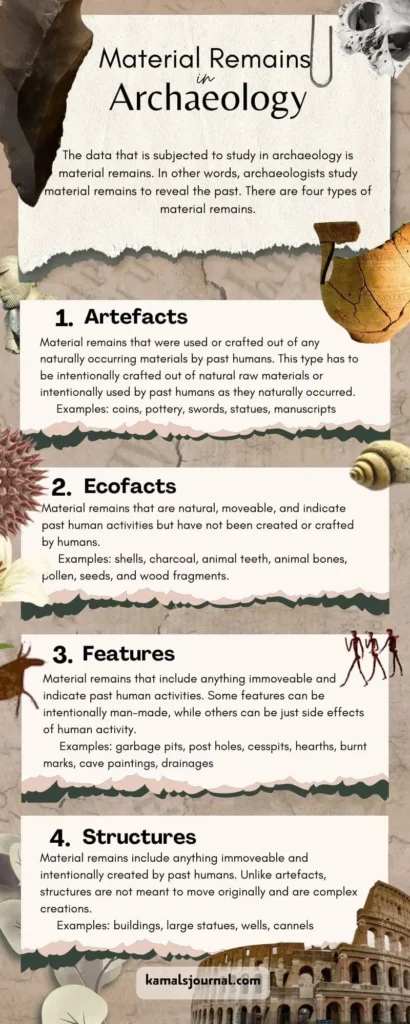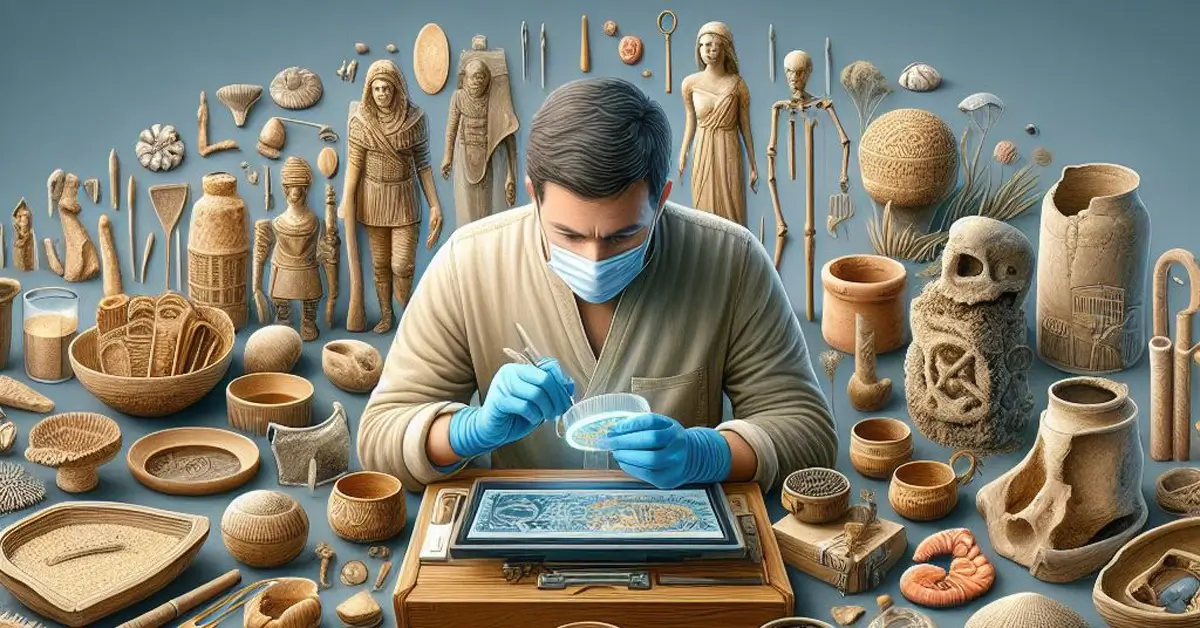What are material remains in archaeology? That is one of the most important questions any archaeology enthusiast or beginner usually asks. Also, the importance of material remains to archaeology is impeccable. So, this article is to discuss everything about material remains in archaeology. This article will go through the following topics:
- meaning of material remains in archaeology
- examples of material remains in archaeology
- types of material remains in archaeology
- artefacts
- ecofacts
- artefacts vs ecofacts comparison
- features
- structures
- features vs structures comparison
- methods of studying material remains
- importance of material remains
- challenges and future of studying material remains
1. What does material remains in archaeology mean?
To begin with, we need to quickly remind ourselves: what is archaeology? Archaeology is the study of past human culture, behaviour, and cognition through material remains left from the past. So, we can see that archaeological studies depend on material remains. That’s why we should study the material remains of archaeology.
Material means physical. Physical means touchable or tangible. Remains means leftovers or surviving fragments. So, in archaeology, material remains means the existing fragments of touchable things left from the past.
We have both touchable and untouchable remains inherent from the past. Our beliefs, religions, knowledge, and traditions are intangible. Those intangible remains of the past are also among us. But in archaeology, we conduct studies based on tangible remains. Hence, the data used for studies in archaeology comes from inspecting tangible remains from the past.
2. What are examples of material remains in archaeology?
There are many forms of material remains we find in archaeology. Coins, inscriptions, paintings, pottery, tools, bones, stone implements, garbage pits, fire pits, engravings, cave floors, fire marks, architectural remains, wrecked ships, and post holes are only a few of them. All of these material remains are classified as archaeology, considering their nature.
3. What are the types of material remains in archaeology?
There are four types of material remains in archaeology, as follows:
- artefacts
- ecofacts
- structures
- features
Each of the material remains we find in archaeological sites belongs to one of the above four types. But one material cannot belong to more than one category. Each of these four types has unique characteristics that distinguish them from others.
So, when we discover material remains in archaeology, we can sometimes determine what type of material we found easily. Sometimes we need to examine something to determine its type. Mostly, when archaeologists discover bone fragments and stone fragments in excavations, they carefully inspect them to determine their types.

4. What are artefacts in archaeology?
Artefacts in archaeology are the types of material remains that were used or crafted out of any naturally occurring materials by past humans. In simple words, artefacts were intentionally crafted out of natural raw materials by past humans. Or, they were intentionally used by past humans, as they naturally occurred.
From the tiniest bead to a large building or statue, every manmade thing belongs to this category. But in most cases, artefacts are moveable. Here, the terms ‘crafted’ and ‘used’ are very important. Because, everthing that occurred in the past is not a artefact. The past humans must have utilised the naturally occurring materials as they were, or they must have created something out of the naturally occurring materials or exsisting artefacts.
We find artefacts in many forms, such as coins, jewellery, statues, potteryware, weapons, tools, ornaments, seals, etc. The goddess Tara statue in the British Museum is one example of an artefact. Some forms of artefacts, such as coins, are easy to recognise as artefacts. But some artefacts, such as bone tools and stone tools, can be quite challenging to recognise. In those instances, a careful inspection is necessary.
5. What are ecofacts in archaeology?
Ecofacts in archaeology are the types of material remains that are natural, moveable, and indicate past human activities. This type indicates past human activities but has not been crafted or utilised by humans. Ecofacts are simply all of the natural remains that have been altered by humans as side effects of their activities. And also ecofacts are moveable.
Ecofacts can be determined by their physical features as well as their contextual occurrence. As an example, imagine that we found one limb bone of a monkey at an archaeological site. If the bone has been crafted into something, we can identify it as an artefact. But if it has not been crafted but has cutmarks or burnt marks, we can identify it as an ecofact. But what if we found an unharmed limb bone of a monkey in a human burial pit? In that case, we can identify it as an ecofact, considering the context. Because that bone could be an indication of a domesticated monkey who got buried with the human ancestor when he died. Accordingly, ecofacts can reveal things about past humans.
We find ecofacts in many forms, such as faunal remains, floral remains, and stones. Simply put, ecofacts consist of shells, bones, wood, pollen, seeds, etc.
6. What is the difference between an artefact and an ecofact?
As you already understand what an artefact is and what an ecofact is, we can discuss the difference between these two types within an interesting example.
Imagine a human ancestor around 1.5 million years ago, in prehistoric times, who had a good hunt and brought it home. When he hunts or butchers the animal, it can leave some cut marks on the bones of the animal he hunted. Or if he burned the meat while the bones were still attached, the bones could be burned. However, after finishing his meal, he may take some bones to create a tool, like a dagger or an arrowhead, and throw away the rest. So, here, there are two types of bones, as follows:
- the bones that got some cutmarks and burntmarks as side effects of our ancestor
- the bones that got crafted into tools intentionally by our ancestor.
The bones that the ancestor crafted into something are artefacts. The bone remains that our ancestor didn’t craft into anything but got altered due to his activities are ecofacts. The common characteristics of artefacts and ecofacts are that both are moveable and indicate past human activities. So, the difference between artefacts and ecofacts in archaeology is the human intention behind the alterations.
7. What are the features of archaeology?
Features in archaeology are the types of material remains that include anything immoveable and indicate past human activities. Unlike artefacts and ecofacts, features are not moveable. Features are physical settings that occur due to human activities. Some features can be intentionally man-made, while others can be just side effects of human activity.
We find features in forms such as buildings, roads, garbage pits, firepits, burnt walls or floors, post holes, drainage canels, hearth marks, cave paintings etc.
8. What are structures in archaeology?
Structures in archaeology are the type of material remains that include anything immoveable and intentionally created by past humans. Unlike artefacts, structures are not meant to move originally. But they were also intentionally crafted by past humans.
We consider large-scale material remains, such as architectural remains, to be structures. They come in many forms, such as tombstones, buildings, statues, etc. And some archaeologists consider structures are a part of features. However, structures are bit of complex creations.
9. What is the difference between structures and features in archaeology?
As you already know the characteristics of both structures and features, we can determine the difference between them with an example. Take a caveman as an example.
A caveman lives in a cave alone. He goes hunting, and he brings his prey to his cave. Then, he lights a fire to burn the meat. He does it in the middle of the cave, in the same place everytime. Then, after having a good meal, the lonely caveman collects rocks from the surroundings and builds a wall covering half of the big entrance to the cave. Then time passes. Millions of years later, we discover that cave somewhere in the world. There we see the remains of a rubble wall, burnt marks on the floor, and paintings on the wall. As you may have already figured, we identify the stone wall as a structure and the burnt mark on the floor and wall paintings as features.
In my opinion, a feature is everything else that is related to past human activites other than artefacts, ecofacts, and structures. Imagine a simple wooden hut in village cultures around 6000 years ago. Human ancestors had round shelters with wooden posts. Those wooden posts, the walls, and the roofing were parts of the structure. Now, years later, we find the holes in the ground where they had erected those wooden posts. We call them post holes. These post holes are not structures, as a post hole is not a part of the original structure. But they are formed as a side effect of creating the structure. So, a posthole should be considered a feature.
10. How are material remains in archaeology studied? What are the methods of analysing material remains in archaeology?
To retrieve data from material remains, archaeologists employ a variety of methods and techniques. These include excavation, laboratory analysis, and the use of advanced technologies.
As you already know, the fundamental method we use to uncover and recover material remains in archaeology is excavation. Through careful digging and recording, archaeologists can unearth artefacts, ecofacts, features, and structures in their original context. This allows for a more accurate interpretation of the past and minimises the risk of damaging or losing important information.
Once archaeologists recover material remains, laboratory analysis plays a crucial role in understanding their composition, age, and function. For example, scientific techniques such as radiocarbon dating can provide precise dates for organic materials, while microscopic analysis can reveal the manufacturing techniques used in pottery or metalwork. Chemical analysis can also identify the sources of raw materials, revealing ancient trade networks and economic systems.
In recent years, the use of advanced technologies has revolutionised the analysis of material remains. For examples, 3D scanning and imaging techniques allow for detailed documentation and virtual reconstruction of artefacts and structures. This not only aids in preservation efforts but also enables researchers to study and analyse material remotely.
11. What is the importance of material remains in archaeology?
The main and obvious importance of material remains in archaeology is that they provide data for archaeological studies. An archaeologist studies material remains to understand the past human culture, behaviour, and cognition. From the earliest human ancestors to ancient civilizations, from ancient monarchs to last-century architecture, everything studied in archaeology is based on material remains.
And as mentioned above in the methods of studying the material remains, a tiny amount of material can provide a significant amount of information. Additionally, you can discover the importance of material remains in the following case studies.
12. Case studies highlighting the significance of material remains
Throughout history, numerous case studies have demonstrated the significance of material remains in understanding past civilizations. Let’s explore a few examples that highlight their importance.
The case study of Pompeii
One such case study is the excavation of Pompeii, a Roman city buried under volcanic ash in 79 AD. The preservation of buildings, artefacts, and even human remains in Pompeii provides an insight into the daily life of the ancient Romans. From intricate frescoes and mosaics to household items and tools, the material remains of Pompeii have allowed archaeologists to reconstruct the social and economic fabric of this ancient city.
The case study of Terracotta Army
Another example is the discovery of the Terracotta Army in China. Discovered in 1974, this vast collection of life-sized clay soldiers was buried with the first emperor of China, Qin Shi Huang. The Terracotta Army not only showcases the incredible craftsmanship and artistic skills of the ancient Chinese but also provides insights into the military organisation and power structure of the Qin Dynasty.
The case study of Maya Hieroglyphics
The study of material remains has also revealed the ancient Maya civilization. The decipherment of Maya hieroglyphic writing, combined with the analysis of artefacts and architectural remains, has revealed the complexity of Maya society and their advanced understanding of mathematics, astronomy, and calendar systems. Material remains such as stelae, codices, and pottery have been instrumental in recreating the history of this civilization.
The case study of NBPW in Anuradhapura
In an excavation in an ancient citadel in Anuradhapura, Sri Lanka, Siran Deraniyagala recovered a piece of NBPW pottery. NBPW means Nothern Black Polished Ware, which originated in Nothern India in the 2nd urbanisation of Ancient India around the 6th century BC. Research team lab-tested the pottery peice and dated to the 6th century BC. That changed the entire literature-based history of Sri Lanka. Meanwhile, the historical texts had emphasised that Sri Lankans were just primitive tribes until the 4th century BC, when Mahinda Thero himself brought civilization to Sri Lanka. But starting with that discovery, the later studies showed evidence that Sri Lanka had a civilization before the 4th century BC, and the connection with northern India was also happening way earlier. Accordingly, Sri Lanka’s proto-history was revealed.
These case studies demonstrate how important material remains are in archaeology.
13. What are the challenges and limitations in studying material remains in archaeology?
While material remains provide valuable insights into the past, studying them is not without its challenges and limitations. The level of preservation always has an impact on the quality and quantity of data that we can retrieve.
Another challenge is the interpretation of the material. Archaeologists must rely on a combination of scientific analysis, historical context, and cultural knowledge to decipher the meaning and significance of material remains. However, interpretations can be subjective and open to different interpretations, leading to ongoing debates and revisions in our understanding of the past.
The availability of funding and resources is also a limitation in the study of material remains. Archaeological excavations and laboratory analysis require significant financial investment and access to specialised equipment and expertise. Limited funding can hinder research efforts, resulting in gaps in our knowledge and understanding of human past.
14. Ethical considerations in handling and preserving material remains
The handling and preservation of material remains raise important ethical considerations. Indigenous communities, in particular, have voiced concerns about the repatriation and respectful treatment of ancestral remains and sacred objects. It is vital for archaeologists and institutions to engage in collaborative and inclusive approaches, involving local communities in the research process and respecting their cultural heritage.
Furthermore, the sustainable management and protection of archaeological sites and material remains are essential. Balancing the need for scientific investigation with the preservation of cultural heritage requires careful planning and responsible stewardship. This involves implementing measures to prevent looting, ensuring proper storage and conservation practises, and promoting public awareness and education about the significance of material remains.
Future prospects and advancements in analysing material remains in archaeology
The field of archaeology is constantly evolving, and advancements in technology continue to revolutionise the study of material remains. The use of remote sensing techniques, such as LiDAR (Light Detection and Ranging), has enabled archaeologists to uncover hidden structures and landscapes without the need for extensive excavation. This not only saves time and resources but also minimises potential damage to archaeological sites.
DNA analysis is another area of advancement in the study of material remains. Ancient DNA extracted from bones, teeth, and even soil can provide insights into ancient populations, migration patterns, and genetic relationships. This interdisciplinary approach, combining archaeology with genetics, holds great potential for understanding the intricate complexities of ancient societies.
Integrating material remains with other sources of archaeological evidence, such as ancient texts and oral traditions, is also a promising avenue for future research. By combining different types of data, researchers can create a more comprehensive and nuanced understanding of the past. This interdisciplinary approach allows for a more holistic interpretation of material remains, enriching our knowledge of ancient civilizations.
Conclusion
In conclusion, material remains are invaluable in archaeology as they are the source of data for archaeology. Material remains are classified as artefacts, ecofacts, features, and structures, and they provide an enormous amount of insight into past human culture, behaviour, and cognition. Archaeologists analyse them, retrieve data, and then interpret the data, adding a historically recognised value to those material remains. Therefore, it is safe to say that material remains from the past carry the knowledge from the past to the present silently. With that knowledge, we can fulfil our curiosity as well as better understand our past and our heritage.

